Creep Behaviour of Thick and Thin Walled Structures - MTU Aero ...
Creep Behaviour of Thick and Thin Walled Structures - MTU Aero ...
Creep Behaviour of Thick and Thin Walled Structures - MTU Aero ...
Create successful ePaper yourself
Turn your PDF publications into a flip-book with our unique Google optimized e-Paper software.
<strong>Creep</strong> <strong>Behaviour</strong> <strong>of</strong> <strong>Thick</strong> <strong>and</strong> <strong>Thin</strong> <strong>Walled</strong> <strong>Structures</strong> <strong>of</strong> a Single Crystal Nickel-Base Superalloy at High<br />
Temperatures – Experimental Method <strong>and</strong> Results<br />
Rainer Hüttner 1) , Rainer Völkl 1) , Johannes Gabel 2) , Uwe Glatzel 1)<br />
1) Metals <strong>and</strong> Alloys, University Bayreuth, D – 95440 Bayreuth, Germany<br />
2) <strong>MTU</strong> <strong>Aero</strong> Engines GmbH, D – 80995 Munich, Germany<br />
uwe.glatzel@uni-bayreuth.de<br />
Abstract<br />
<strong>Creep</strong> behavior <strong>of</strong> the single crystal nickel-base superalloy<br />
René N5 is investigated as a function <strong>of</strong> material thickness. The<br />
results point out that reducing the thickness form 1.0 to 0.2 mm<br />
leads to both shorter creep lives <strong>and</strong> much higher overall creep<br />
strain rates <strong>of</strong> thin specimens. The orientation <strong>of</strong> the specimen is<br />
an important factor too but has a weaker influence on creep<br />
behavior under the given test conditions than the specimen<br />
thickness.<br />
Introduction<br />
Single crystal nickel-base superalloys are used in blades <strong>and</strong><br />
vanes <strong>of</strong> stationary gas turbines <strong>and</strong> aero engines. Their lifetimes<br />
are mainly limited by fatigue, creep <strong>and</strong> hot corrosion at elevated<br />
service temperatures. To increase lifetime a possible strategy is to<br />
reduce the material temperature by cooling. In order to optimize<br />
both the cooling efficiency <strong>and</strong> the weight <strong>of</strong> fast rotating turbine<br />
blades a general trend is to reduce the wall thickness <strong>of</strong> the hollow<br />
investment casting parts.<br />
The relation between creep properties <strong>and</strong> section thickness was<br />
rarely investigated [1-10]. For the polycrystalline nickel-base<br />
superalloy PWA 1484 Duhl [1] found a five fold reduction <strong>of</strong><br />
creep rupture life if the specimen thickness is diminishing from 4<br />
to 0.5 mm which mainly depend on grain size <strong>and</strong> micro structural<br />
defects. Doner <strong>and</strong> Heckler [3, 4] observed in uncoated single<br />
crystal CMSX-3 a 30% loss in creep rupture life if the wall<br />
thickness was reduced from 3.18 to 0.76 mm at 982°C <strong>and</strong> if the<br />
stress level was below 275 MPa. They also found that the time to<br />
reach 1% strain was unaffected by wall thickness at a constant<br />
stress level. Seetharaman <strong>and</strong> Cetel [6] reported similar results for<br />
single crystal PWA 1484 with wall thicknesses <strong>of</strong> 1.76 <strong>and</strong><br />
0.38 mm respectively <strong>and</strong> stresses below 275 MPa at 982°C. They<br />
concluded that oxidation <strong>and</strong> the more constrained plastic<br />
deformation are the major contributions for early failure <strong>of</strong> thin<br />
specimens. Doner <strong>and</strong> Heckler [3, 4] found that creep rupture<br />
properties <strong>of</strong> aluminized nickel-base superalloys are less<br />
influenced by the specimen thickness. By contrast Seetharaman<br />
<strong>and</strong> Cetel [6] mentioned a loss <strong>of</strong> creep rupture lifetime <strong>of</strong> 30-<br />
40% with a thickness reduction from 1.52 to 0.25 mm for coated<br />
Knowledge <strong>and</strong> underst<strong>and</strong>ing <strong>of</strong> the creep behavior is a<br />
fundamental prerequisite for component life-time predictions.<br />
Therefore the effect <strong>of</strong> thickness reduction on the creep properties<br />
<strong>of</strong> uncoated <strong>and</strong> aluminized single crystal nickel-base superalloy<br />
René N5 is investigated in this study. In addition deviations from<br />
the [001] orientation are incorporated into this study which is part<br />
<strong>of</strong> a ongoing research carried out for the next years.<br />
Experimental<br />
A cast <strong>and</strong> heat-treaded single crystal plate <strong>of</strong> René N5 was<br />
provided. Chemical composition is found elsewhere [11]. The<br />
plate was oriented by Laue back scattered diffraction <strong>and</strong> several<br />
slices with an angle <strong>of</strong> 16° <strong>of</strong>f the [001] zone axis towards the<br />
Keywords: thickness, single crystal, creep, coating,<br />
direction <strong>and</strong> in exact [001] orientation were cut by wire<br />
electrical discharge machining. Observations <strong>of</strong> Sass et al. [12]<br />
have shown that the influence <strong>of</strong> orientation deviation towards the<br />
direction is less serve than deviation towards the <br />
direction. Two series <strong>of</strong> thick <strong>and</strong> thin tension specimens<br />
(geometries 95×3×1 mm³ <strong>and</strong> 95×4×0.2 mm³ respectively) were<br />
cut from the 16° miss-oriented slice <strong>and</strong> two specimen series<br />
(geometries 95×3×1 mm³ <strong>and</strong> 95×4×0.3 mm³ respectively) were<br />
cut from the [001] oriented slice.<br />
Fig. 1: Scheme <strong>of</strong> ultra-high temperature test facility.<br />
Specimens were tested with an 40 μm aluminum coating <strong>and</strong><br />
without coating. Constant load tensile creep test were performed<br />
at 980°C for three stress levels, 230, 270 <strong>and</strong> 300 MPa till rupture<br />
<strong>of</strong> the specimens. The raw data was fit with Bezier splines [13]<br />
<strong>and</strong> the results for different specimen thicknesses in both<br />
orientations <strong>and</strong> with different surface conditions are presented.<br />
Proprietary test facilities with Ohmic heating [13-16] were used in<br />
this study. The test facilities permit tests either in air, vacuum or<br />
under a protective gas atmosphere. A scheme <strong>of</strong> the test facilities<br />
is given in Fig. 1. Strain between ridges in the central zone <strong>of</strong> the<br />
specimen (Fig. 2a) is measured with sub pixel accuracy by means<br />
<strong>of</strong> a CCD camera controlled by the s<strong>of</strong>tware Super<strong>Creep</strong> [13-16].<br />
At a maximum measurable strain <strong>of</strong> ε ≈ 60%, an error <strong>of</strong><br />
Δε ≈ ±7·10 -4 for a single strain measurement was determined<br />
[14,15]. By mean filtering over about 1500 single measurements
or 60 s respectively an error <strong>of</strong> the mean strain <strong>of</strong> Δ ε ≈ ±3·10 -5<br />
was deduced [15].<br />
Temperature is controlled with a dual color pyrometer to<br />
overcome problems due to unknown emissivity. The temperature<br />
distribution at the specimen was measured by a second pyrometer<br />
(Fig. 2b). The temperature at the specimen centre was 980°C<br />
whereas at the ridges slightly lower temperatures <strong>of</strong> about 975°C<br />
were measured. In a zone 30 mm around the specimen centre the<br />
temperature was 980 ± 5°C.<br />
a)<br />
b)<br />
Fig. 2:<br />
a) Bright specimen at 980°C with 4 ridges for strain measurement.<br />
b) Temperature distribution along a René N5 specimen. The<br />
distance between grips was 75 mm.<br />
Results<br />
<strong>Creep</strong> tests on 16° miss-oriented René N5 specimens<br />
0.2 mm as well as 1 mm thick specimens show typical creep<br />
curves with decreasing creep rate until minimum creep rates are<br />
reached followed by steadily increasing creep rate (Fig. 3 <strong>and</strong> 4).<br />
Minimum creep rates <strong>of</strong> thin specimens are about one order <strong>of</strong><br />
magnitude higher than 1.0 mm thick specimens (Fig. 3b <strong>and</strong> 4).<br />
Strain to failure remained below 5% for 0.2 mm thick specimens<br />
under all applied loads, whereas fracture strains were always<br />
above 20% for 1 mm thick specimens (Fig. 4). By reduction <strong>of</strong><br />
specimen thickness from 1 to 0.2 mm the creep rupture life is<br />
reduced by a factor <strong>of</strong> 4 to 5.<br />
strain [ %]<br />
5<br />
4<br />
3<br />
2<br />
1<br />
0<br />
300 MPa<br />
270 MPa<br />
230 MPa<br />
0.2 mm<br />
miss-oriented<br />
0 10 20 30 40 50<br />
time [h]<br />
a) Strain vs. time creep curves<br />
10-3 strain rate [1/s]<br />
10 -4<br />
10 -5<br />
10 -6<br />
10 -7<br />
10 -8<br />
10 -9<br />
300 MPa<br />
270 MPa<br />
230 MPa<br />
0.2 mm<br />
miss-oriented<br />
0.00 0.01 0.02 0.03 0.04 0.05<br />
strain<br />
b) Strain rate vs. strain creep curves<br />
Fig. 3: René N5, 16° miss-oriented, 0.2 mm, 980°C.<br />
strain rate [1/s]<br />
10 -3<br />
10 -4<br />
10 -5<br />
10 -6<br />
10 -7<br />
10 -8<br />
10 -9<br />
300 MPa<br />
270 MPa<br />
230 MPa<br />
1 mm<br />
miss-oriented<br />
0.00 0.05 0.10 0.15<br />
strain<br />
0.20 0.25 0.30<br />
Fig. 4: Strain rate vs. strain creep curves, René N5, 16° missoriented,<br />
1.0 mm, 980°C.
<strong>Creep</strong> tests on 16° miss-oriented <strong>and</strong> aluminised René N5<br />
specimens<br />
Fig. 5 shows the creep behavior <strong>of</strong> 1.0 mm thick samples with<br />
aluminised coating. A comparison between aluminised <strong>and</strong> not<br />
aluminised specimens (Fig. 4 <strong>and</strong> 5) reveals no systematic<br />
improvement in rupture times for coated 1 mm thick samples.<br />
strain rate [1/s]<br />
10 -3<br />
10 -4<br />
10 -5<br />
10 -6<br />
10 -7<br />
10 -8<br />
10 -9<br />
300 MPa<br />
230 MPa<br />
270 MPa<br />
1 mm<br />
miss-oriented<br />
aluminised<br />
0.00 0.05 0.10 0.15<br />
strain<br />
0.20 0.25 0.30<br />
Fig. 5: Strain rate vs. strain creep curves, René N5, 16° missoriented,<br />
aluminised, 1.0 mm, 980°C.<br />
<strong>Creep</strong> tests on [001] oriented René N5 specimens<br />
Very important for creep resistance is the orientation <strong>of</strong> a single<br />
crystal sample. Results for specimens without coating are<br />
presented in Fig. 6 <strong>and</strong> 7.<br />
Specimen thickness has also an influence on creep rupture time<br />
<strong>and</strong> rupture strain for [001] orientation, however the effect is<br />
strongest at low stress <strong>of</strong> 230 MPa where the creep time was<br />
reduced by a factor <strong>of</strong> 2. Rupture strains <strong>of</strong> 0.3 mm thick<br />
specimens were generally lower than for 1.0 mm thick specimens<br />
while minimum creep rates do not change significantly for the<br />
same load (compare Fig. 6 <strong>and</strong> 7).<br />
strain rate [1/s]<br />
10 -3<br />
10 -4<br />
10 -5<br />
10 -6<br />
10 -7<br />
10 -8<br />
10 -9<br />
300 MPa<br />
270 MPa<br />
230 MPa<br />
0.3 mm<br />
[001] oriented<br />
0.00 0.05 0.10 0.15<br />
strain<br />
0.20 0.25 0.30<br />
Fig. 6: Strain rate vs. strain creep curves, René N5, [001] oriented,<br />
0.3 mm, 980°C<br />
strain rate [1/s]<br />
10 -3<br />
10 -4<br />
10 -5<br />
10 -6<br />
10 -7<br />
10 -8<br />
10 -9<br />
300 MPa<br />
270 MPa<br />
230 MPa<br />
1 mm<br />
[001] oriented<br />
0.00 0.05 0.10 0.15<br />
strain<br />
0.20 0.25 0.30<br />
Fig. 7: Strain rate vs. strain creep curves, René N5, [001] oriented,<br />
1.0 mm, 980°C<br />
strain rate [1/s]<br />
10 -3<br />
10 -4<br />
10 -5<br />
10 -6<br />
10 -7<br />
10 -8<br />
10 -9<br />
300 MPa<br />
270 MPa<br />
230 MPa<br />
0.3 mm<br />
[001]oriented<br />
aluminised<br />
0.00 0.05 0.10 0.15<br />
strain<br />
0.20 0.25 0.30<br />
Fig. 8: Strain rate vs. strain creep curves, René N5, [001] oriented,<br />
aluminised, 0.3 mm, 980°C<br />
10-3 strain rate [1/s]<br />
10 -4<br />
10 -5<br />
10 -6<br />
10 -7<br />
10 -8<br />
10 -9<br />
300 MPa<br />
230 MPa<br />
270 MPa<br />
1 mm<br />
[001]oriented<br />
aluminised<br />
0.00 0.05 0.10 0.15<br />
strain<br />
0.20 0.25 0.30<br />
Fig. 9: Strain rate vs. strain creep curves, René N5, [001] oriented,<br />
aluminised, 1.0 mm, 980°C
Tabel 1: Data for rupture lifetime [h]/minimum creep rate<br />
[10 -9 s -1 ] as function <strong>of</strong> thickness <strong>and</strong> coating for RenéN5 single<br />
crystals at 980°C testing temperature<br />
Wallthicknesss<br />
[mm]<br />
0.2/0.3<br />
1<br />
Stress<br />
levels<br />
[MPa]<br />
16°<br />
missoriented<br />
no coating aluminised<br />
[001]<br />
oriented<br />
[001]<br />
oriented<br />
230 35/112 45/71 115/29<br />
270 16/239 12/383 33/122<br />
300 7/467 6/391 24/46<br />
230 302/2.4 110/59 321/5.4<br />
270 117/19 19/376 103/17.4<br />
300 21/117 9/485 60/73<br />
<strong>Creep</strong> test on [001] oriented <strong>and</strong> aluminised René N5 specimens<br />
Comparing Fig. 8 <strong>and</strong> Fig. 9 reveals that 1 mm thick aluminised<br />
specimens reach higher rupture strains <strong>and</strong> lower creep rates than<br />
0.3 mm thick samples. All 1 mm thick specimens rupture after<br />
reaching about 20% strain. <strong>Thin</strong> samples only reach 5% for lower<br />
stress levels <strong>and</strong> 11% for 300 MPa. Minimum creep rates <strong>of</strong> thick<br />
samples are lower than for thin samples. Aluminised <strong>and</strong> [001]<br />
oriented samples show higher creep rupture times <strong>and</strong> lower<br />
minimum creep rates than not aluminised samples if the stress was<br />
referred to the remaining cross sectional area without TGO.<br />
Discussion<br />
The results pronounce that the creep behavior is strongly<br />
influenced by the surface to volume ratio <strong>of</strong> the specimens.<br />
The time to reach 1% creep strain which was mentioned in [3,4,6]<br />
to be independent <strong>of</strong> wall-thickness could be approved for non<br />
coated specimens at a stress level <strong>of</strong> 300 MPa for 16° missoriented<br />
specimens.<br />
16° miss-oriented René N5 specimens<br />
time to reach 1% strain [h]<br />
200<br />
150<br />
100<br />
50<br />
1mm<br />
0.2 mm<br />
16° <strong>of</strong>f oriented<br />
1mm-aluminised<br />
0<br />
230 240 250 260 270 280 290 300<br />
Stress [MPa]<br />
Fig. 10: René N5 with 16° misorientation. Times to 1% creep<br />
strain.<br />
[001] oriented René N5 specimens<br />
time to reach 1% strain [h]<br />
200<br />
150<br />
100<br />
50<br />
0.3 mm-aluminised<br />
1mm<br />
0.3 mm<br />
perfect [001] orientatiod<br />
1mm-aluminised<br />
0<br />
230 240 250 260 270 280 290 300<br />
Stress [MPa]<br />
Fig. 11: René N5 with an [001] orientation. Times to 1% creep<br />
strain.<br />
For [001] oriented René N5 specimens the time to reach 1% creep<br />
strain was roughly equal for not aluminised specimens for all<br />
levels tested here. For aluminised specimens the time to reach 1%<br />
creep strain was dependent on wall-thickness.<br />
Conclusions<br />
The creep behavior <strong>of</strong> single crystal René N5 at 980°C was<br />
investigated as function <strong>of</strong> sample thickness, orientation <strong>and</strong><br />
coating conditions.<br />
• First results point out that reducing the wall thickness from<br />
1.0 to 0.2 or 0.3 mm leads to lower creep rupture strains,<br />
lower life times <strong>and</strong> higher minimum creep strain rates.<br />
• The creep behavior <strong>of</strong> 16° miss-oriented compared to perfect<br />
orientation are similar.<br />
• Not aluminised René N5 specimens are less influenced by<br />
thickness changes.<br />
Further investigations on microstructure especially <strong>of</strong> surface<br />
features will be carried as described in [17] in order to further<br />
underst<strong>and</strong> the mechanics leading to these observations.<br />
Acknowledgements<br />
The authors gratefully acknowledge financial support by the<br />
Deutsche Forschungsgemeinschaft (German Research<br />
Foundation), DFG through Graduiertenkollegg GRK 1229 <strong>and</strong><br />
Forschergruppe FOR 727.<br />
References<br />
[1] D.N. Duhl: “Directional Solidified Superalloys”, in<br />
Superalloys II, C.T. Sims, N.S. Stol<strong>of</strong>f, <strong>and</strong> W.C. Hagel, (Eds.),<br />
(John Wiley, New York, 1987), 189-214<br />
[2] P.J. Henderson: “<strong>Creep</strong> <strong>of</strong> coated <strong>and</strong> uncoated thin -<br />
section CMSX – 4”, Materials for Advanced Power Engineering<br />
(Forschungszentrum Juelich GmbH, 1998), 1559-1568<br />
[3] M. Doner <strong>and</strong> J.A. Heckler: “Effects <strong>of</strong> Section<br />
thickness <strong>and</strong> Orientation on creep rupture properties <strong>of</strong> two<br />
advanced single crystal alloys”, in SAE Technical Paper 851785,<br />
(Society <strong>of</strong> Automotive Engineers Inc., 1985)<br />
[4] M. Doner <strong>and</strong> J.A. Heckler: “Identification <strong>of</strong><br />
Mechanisms responsible for Degradation in thin-wall stress<br />
rupture properties”, in Superalloys 1988, Proceedings <strong>of</strong> the 6 th<br />
International Symposium on Superalloys (The Metallurgical<br />
Society, Warrendale, PA, 1988), 653-662,
[5] N. Roy <strong>and</strong> R.N. Ghosh: “Modelling effects <strong>of</strong><br />
specimen size <strong>and</strong> shape on creep <strong>of</strong> metals <strong>and</strong> alloys”, Scripta<br />
Materialia, 36 (12) (1997), 1367-1372,<br />
[6] V. Seetharaman <strong>and</strong> A.D. Cetel: “<strong>Thick</strong>ness debit in<br />
creep properties <strong>of</strong> PWA 1484” in Superalloys 2004, ed K. A.<br />
Green et al., (TMS,2004), 207-214,<br />
[7] M.C. P<strong>and</strong>ey <strong>and</strong> D.M.R. Taplin: ”Prediction <strong>of</strong> lifetime<br />
in thin sections <strong>of</strong> a nickel base superalloy”, Scripta Meallurgica<br />
et Maerialia, 31 (6) (1994), 719-722,<br />
[8] P.J. Henderson: “<strong>Creep</strong> <strong>of</strong> single crystal Ni-base<br />
superalloy in thick <strong>and</strong> thin section forms” in <strong>Creep</strong> <strong>and</strong> Fracture<br />
<strong>of</strong> Engineering materials <strong>and</strong> structures, ed. J.C. Earthman <strong>and</strong><br />
F.A. Mohamed, (1997), 697-706<br />
[9] A. Baldan: “On the thin-section size dependent creep<br />
strength <strong>of</strong> a single crystal nickel-base superalloy”, Journal <strong>of</strong><br />
Materials Science, 30 (1995), 6288-6298,<br />
[10] A. Baldan: “Combined effects <strong>of</strong> thin-section size, grain<br />
size <strong>and</strong> cavities on the high temperature creep fracture properties<br />
<strong>of</strong> a nickel-base superalloy, Journal <strong>of</strong> Materials Science, 32<br />
(1997) 35-45,<br />
[11] Y. Koizum: “Database <strong>of</strong> <strong>Creep</strong> Propertiy for Nickel-Base<br />
Single Crystal Superalloys, RenéN4, RenéN5 <strong>and</strong> CMSX-4”,<br />
Journal <strong>of</strong> Japan Inst. Metals, 40 (2) (2006), 176-179<br />
[12] V. Sass, U. Glatzel, M. Feller-Kniepmeier:“ Anisotropic<br />
creep properties <strong>of</strong> the Nickel-base superalloy CMSX-4“, Acta<br />
materialica, 44 (5) (1996), 1967-1977<br />
[13] R. Völkl, D. Freund, B. Fischer: “Economic <strong>Creep</strong><br />
Testing <strong>of</strong> Ultra-High Temperature Alloys”, Journal <strong>of</strong> Testing &<br />
Evaluation, 31 (1) (2003), 35-43<br />
[14] R. Völkl, B. Fischer: “Mechanical Testing <strong>of</strong> Ultra-High<br />
Temperature Alloys”, Mechanical Testing, 44 (2) (2004), 121-127<br />
[15] R. Völkl, , B. Fischer, M. Beschliesser <strong>and</strong> U. Glatzel,<br />
„Evaluating strength at ultra-high temperatures – methods <strong>and</strong><br />
results“ Materials Science & Engineering A, in press 2008<br />
[16] B. Fischer, S. Vorberg, R. Völkl, M. Beschliesser, A.<br />
H<strong>of</strong>fmann: “<strong>Creep</strong> <strong>and</strong> tensile tests on refractory metals at<br />
extremely high temperatures”, Int. Journal <strong>of</strong> Refractory Metals &<br />
Hard Materials, 24 (2006), 292-297<br />
[17] S. Wöllmer, T. Mack, M. Göken, S. Zaefferer, U. Glatzel:<br />
“Characterization <strong>of</strong> Phases <strong>of</strong> Aluminized Nickel Base<br />
Superalloys”, Surface <strong>and</strong> Coating Technology, 167 (2003), 83-96


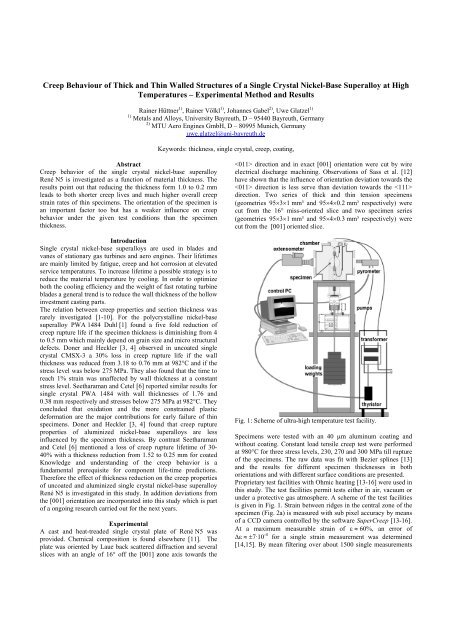


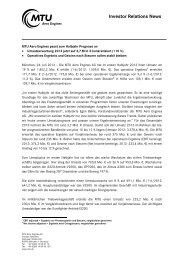
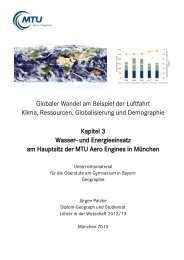
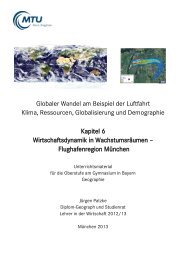
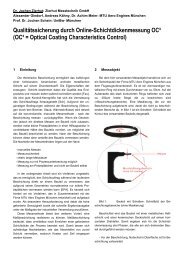
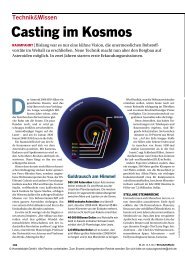

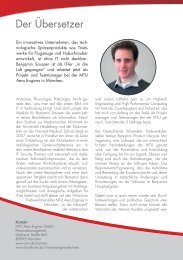
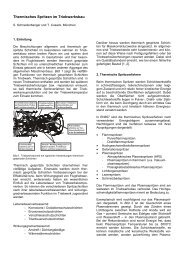
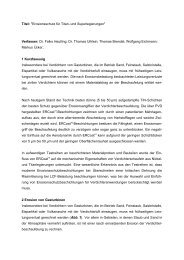


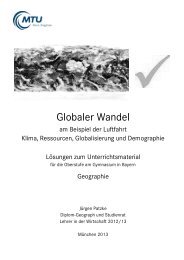
![Download PDF [5,37 MB] - MTU Aero Engines](https://img.yumpu.com/21945461/1/190x125/download-pdf-537-mb-mtu-aero-engines.jpg?quality=85)